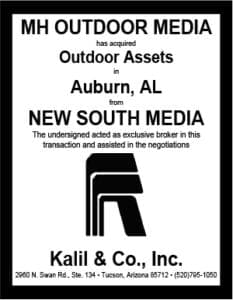
We had a computer glitch yesterday morning that prevented this post from linking to the Billboard Insider main web site. We did get it fixed, but we know there were a few of you that might have missed this outstanding conversation with Max, which is why we are running it again this morning.
Max, How would you describe the deal market in 2023?
In a word, choppy. Strong assets will trade well in any climate, however the market has changed compared to the peak of 2021 & 2022. The primary difference is deal flow. Similar to the Great Recession, deal flow has slowed down significantly. Multiples have softened slightly, from a general average of 11x-13x BCF during the recent peak conditions to the majority of deals trading between 10x-11.5x BCF today. $5m – $15m deals are still getting done, however, the larger domestic deals are more frozen now than in recent years.
What were the economic factors that contributed to the choppiness?
Higher interest rates generally apply downward pressure on valuation and buyer ability. However, we are seeing much more resilience in OOH than in other sectors (real estate/office, other traditional media verticals, upstream/extraction in energy, manufacturing etc.). There are some serious geopolitical issues worldwide that also have an impact on perspectives going forward. At the end of the day, the people making decisions on buying and selling are looking at the news and wondering if now is a good time to buy, considering the next twelve months maintain a chance of being more challenging than the last twelve. That said, the people in my network all seem to maintain a universal bullishness on OOH’s long-term viability, so while activity may be slow today, I have no doubt current market conditions are temporary and just part of the cycle.
Another item of note that reminds me of the last recession is the reoccurrence of large transit contracts being a problem. Fifteen years ago, the London Underground was a $150,000,000 per year liability for what was then CBS Outdoor, and now Outfront is writing down over $500m in value through an impairment charge on their NYC/MTA subway contract. I believe part of the solution here is that our industry’s municipal partners need to come to terms with their asks being unprofitable for their partners. Absent some level-headed decision making on their part, I could see them losing substantial revenue streams simply by spooking away the most qualified partners based on their unreasonable splits and guarantee requirements. Subway ridership levels going forward are anyone’s guess. In my opinion, if the OOH partner is going to be required to make these material guarantees, the municipal partner should be making meaningful investments in proliferating cell service and wifi between terminals, enhancing passenger safety, and modernizing the comfort and aesthetics of our subway systems to maximize ridership levels.
Any particular deals of note in 2023?
The Lamar & Bill Salter deal comes to mind. I believe it is the largest acquisition to take place in the U.S. so far this year, but the noteworthy part of the deal was its history and future. Bill Salter started his business in the 1950s in Pensacola, the same market Lamar started in back in 1902. While Lamar went nationwide, Mr. Salter doubled down on the Emerald Coast and built an excellent portfolio in Pensacola and its surrounding markets. They had a competitive relationship for many decades; however, it was evident during the negotiations that there was underlying mutual respect between both sides. Mr. Salter asked Sean to come to Pensacola to discuss the deal in person, and we had a great meeting. Sean outlined their proposed deal terms and process, which were agreeable to Mr. Salter, and Lamar delivered on their promises. After 70+ years of earnest competition, we ended up closing the deal in person with smiles and handshakes between Mr. & Mrs. Salter and Ross. We expect Lamar to do very well with the acquisition, as the deal was an excellent fit for them.
We are seeing a lot of activity internationally – with CCO exiting Europe and Outfront’s recent divestiture in Canada. We have an active engagement in London and are learning a lot about the Australian market. Activity worldwide does seem to mirror what is happening here in the U.S., however we do see more transactions taking place domestically than abroad.
Has there been any shift in value drivers in today’s marketplace?
There is more of a focus on trailing/actual performance than pro forma at the moment. Market share remains the most important value component, with ground portfolio, asset makeup, upside etc. also at the forefront of buyers’ minds. We are seeing more traction in smaller/medium-sized markets with higher ratios of local revenue vs. national, which has been more sporadic recently.
Do you have any insight into 2024?
Everyone seems to have a different opinion on interest rates, so I won’t get involved in that debate, but I do have experience in election years. Usually, and often despite market conditions, momentum builds in early summer, with political revenue starting to hit late summer, and often serious movement as the election draws near. I’m expecting the same to occur this upcoming year, as change – or the potential for change – can catalyze increased activity. Also, I predict OOH’s share of political revenue to continue to grow because of digital and am expecting a major leap in 2024.
If an operator is sidelined from acquisitions based on rate increases or other, what can they do to grow their business through a downturn?
These market conditions are industry-agnostic, meaning they are affecting everyone to some extent. Many landlords own businesses or may have pressure or see investment opportunities today they’d like to act on. I believe it would be prudent to reach out to as many of your landlords as possible in regard to purchasing an easement to replace your lease. Deals with significant easement portfolios always get more attention and better multiples than deals that feature predominantly leased locations. Further, underwriting an easement location registers the term at 99 years, which does a lot for increasing the average lease term remaining on a portfolio. My suggestion is to buy as many easements beneath your locations as possible. I have yet to meet an operator who regretted doing so, and uncertain times are often the best time to get traction with landlords on a cash buyout.
To receive a free morning newsletter with each day’s Billboard insider articles email info@billboardinsider.com with the word “Subscribe” in the title. Our newsletter is free and we don’t sell our subscriber list.
Paid Advertisement

















